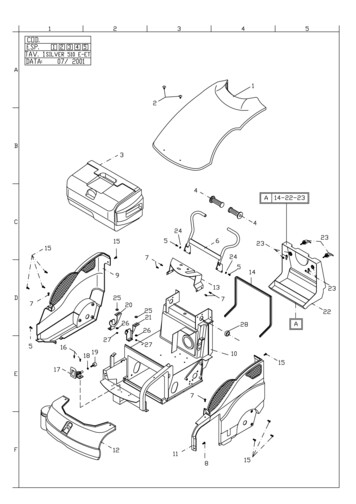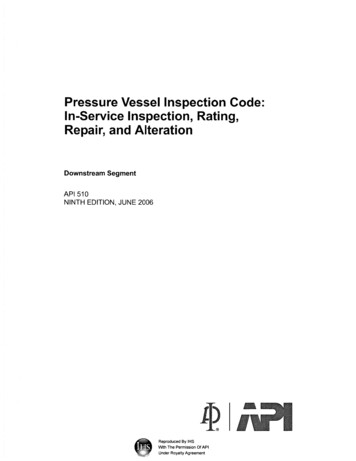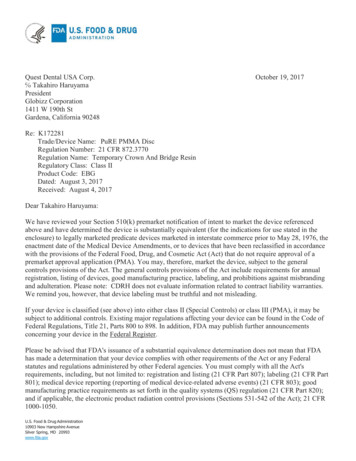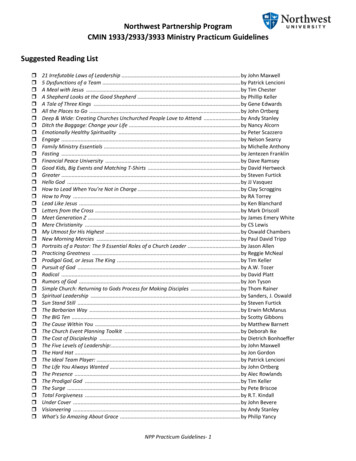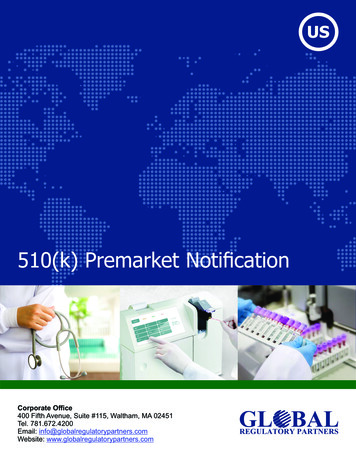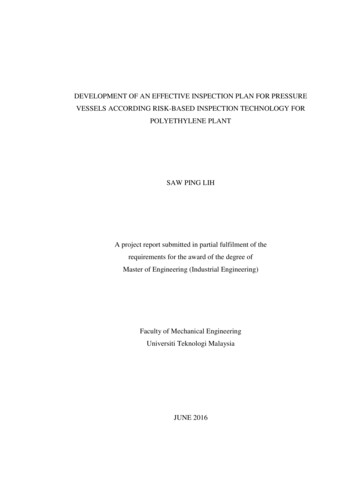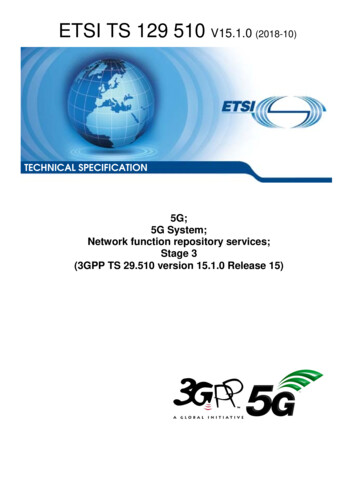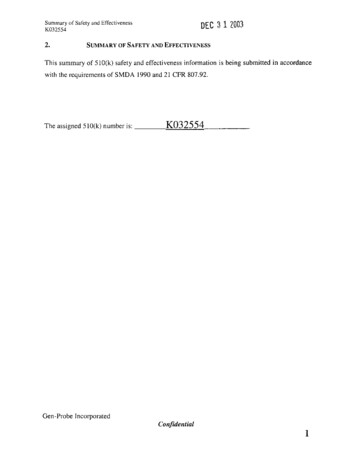
Transcription
DEC 31 Z003Summary of Safety and EffectivenessK0325542.SUMMARY OF SAFETY AND EFFECTIVENESSThis summary of 510(k) safety and effectiveness information is being submitted in accordancewith the requirements of SMDA 1990 and 21 CFR 807.92.The assigned 510(k) number is:K032554Gen-Probe IncorporatedConfidential1
Summary of Safety and EffectivenessK032554GEN-PROBE APTIMA Combo 2 AssayGEN-PROBE APTIMA Vaginal Swab Specimen Collection KitSponsor/Contact InformationSubmitted By:Gen-Probe Incorporated10210 Genetic Center DriveSan Diego, California 92121(858) 410-8000(858) 410-8622 (FAX)Company Contact:Alan Maderazo, Ph.D., RACRegulatory Affairs Specialist(858) 410-8332(858) 410-8622(FAX)alanma@gen-probe.comGen-Probe IncorporatedConfidential2
Summary of Safety and EffectivenessK032554General InformationTrade Name:GEN-PROBE APTIMA Combo 2 AssayCommon or Usual Name:Ribosomal RNA (rRNA) target-amplified nucleic acid probetest for the in vitro diagnostic detection of Chlamydiatrachomatis and/or Neisseria gonorrhoeaeClassification Names:DNA Probe, Nucleic Acid Amplification, ChlamydiaDNA Reagents, NeisseriaAPTIMA Combo 2 AssayDevice Description DNA Probe, Nucleic Acid Amplification, ChlamydiaMedical Specialty MicrobiologyProduct Code MKZDevice Class IRegulation number 866.3120Device DescriptionMedical SpecialtyProduct CodeDevice ClassRegulation numberDNA Reagents, NeisseriaMicrobiologyLSL2866.3390Substantially Equivalent Devices:APTIMA Combo 2 Assay; K003395Gen-Probe IncorporatedConfidential3
Summary of Safety and EffectivenessK032554Device DescriptionClearance of this premarket notification extends the clinical performance claims of thecommercially available GEN-PROBE APTIMA Combo 2 Assay to include clinician-collectedand patient-collected vaginal swabs (in a medical setting) as acceptable testing specimens. Theancillary kit formulated for this specific application is the GEN-PROBE APTIMA VaginalSwab Specimen Collection Kit. The components of the APTIMA Vaginal Swab SpecimenCollection Kit include: (1) a sterile swab for the collection of vaginal specimens and (2) atransport tube containing transport media with a penetrable cap.The APTIMA Vaginal Swab Specimen Collection Kit is for use with the APTIMA Assays forthe detection of Chlanmydia trachomatis and Neisseria gonorrhoeae. The APTIMA VaginalSwab Specimen Collection Kit is intended to be used for clinician and patient collection ofvaginal swab specimens according to the instructions provided. The APTIMA Vaginal SwabSpecimen Collection Kit not for home use.The background information describing the relevant diseases, Chlamydia trachomatis andNeisseria gonorrhoeae, and the principles of the APTIMA Combo 2 Assay are provided in theSummary of Safety and Effectiveness for the APTIMA Combo 2 Assay (K003395)Gen-Probe IncorporatedConfidential4
Summary of Safety and EffectivenessK032554Intended UseAC2 Assay package insert:The APTIMA Combo 2 Assay is a target amplification nucleic acid probe test that utilizestarget capture for the in vitro qualitative detection and differentiation of ribosomal ribonucleicacid (rRNA) from Chlamydia trachomatis and/or Neisseria gonorrhoeae in clinician-collectedendocervical, vaginal, and male urethral swab specimens, patient-collected vaginal swabspecimens* and male and female urine specimens. The assay may be used to test specimensfrom symptomatic and asymptomatic individuals to aid in the diagnosis of gonococcal and/orchlamydial urogenital disease.*Patient-collected vaginal swab specimens are an option for screening women when a pelvicexam is not otherwise indicated. The vaginal swab specimen collection kit is not for home use.Ancillary Kit package insert:The APTIMA Vaginal Swab Specimen Collection Kit is for use with the APTIMA Assays forthe detection of Chlainydia trachomatis and Neisseria gonorrhoeae. The APTIMA VaginalSwab Specimen Collection Kit is intended to be used for clinician and patient collection ofvaginal swab specimens according to the instructions provided. Patient-collected vaginal swabspecimens are an option for screening women when a pelvic exam is not otherwise indicated.The APTIMA Vaginal Swab Specimen Collection Kit is not for home use.Gen-Probe IncorporatedConfidential5
Summary of Safety and EffectivenessK032554Summary of Technological Characteristics of the APTIMA Combo 2 AssayThe APTIMA Combo 2 Assay incorporates the technologies of target capture, in vitro nucleicacid amplification, and hybridization of target amplicons with acridinium ester-labeled DNAprobes to specifically detect and differentiate both C. trachornatisand N. gonorrhoeae nucleicacids in clinical specimens. GEN-PROBE's proprietary technologies are combined in thisproduct to allow qualitative detection of C. trachomatisrRNA and N. gonorrhoeaerRNA.Analytical SensitivityChlanmydia trachornatis analytical sensitivity (limits of detection) was determined by directlycomparing dilutions of C. trachomatisorganisms in cell culture and in the assay. The analyticalsensitivity claim for the assay is one Inclusion-Forming Unit (IFU) per assay (7.25 IFU/swab, 5IFU/mL urine) for all 15 C. trachomatis serovars. However, dilutions of less than oneIFU/assay of all serovars tested positive in the APTIMA Combo 2 Assay.Neisseria gonorrhoeae analytical sensitivity was determined by directly comparing dilutions of57 different clinical isolates in culture and in the APTIMA Combo 2 Assay. The analyticalsensitivity claim for the assay is 50 cells/assay (362 cells/swab, 250 cells/mL urine). However,all strains tested were positive at less than 50 cells/assay.Gen-Probe IncorporatedConfidential6
Summary of Safety and EffectivenessK032554Analytical SpecificityA total of 154 culture isolates were evaluated using the APTIMA Combo 2 Assay. Theseisolates included 86 organisms that may be isltdfrom the urogenital tract and 68 additionalorganisms that represent a phylogenetic cross-section of organisms. The tested organismsincluded bacteria, fungi, yeast, parasites, and viruses. All organisms except C. psittaci, C.pneumoniae, and the viruses were tested at .OX 106 cells/assay in both swab and urine transportmedium. C. psittaci and C. pneumnoniae were tested at 1.OX10IFU/assay. The viruses weretested as follows: (a) herpes simplex viruses I and 1I: 6.Ox 104 TCID5 o/assay, (b) humanpapilloma virus 16: 2.9x 106 DNA copies/assay and (c) cytomegalovirus: lXlO6 infected cellculture cells/assay. Only C. trachornatisand N. gonorrhoeae samples produced positive resultsin the APTIMA Combo 2 Assay. The list of organisms tested is shown in the following table.Gen-Probe IncorporatedConfidential7
Summary of Safety and EffectivenessK032554Analytical SpecificityORGANISMORGANISMEscherichia icumnAcinetobacter calcoaceticusFusobacteriumnucleatumAcinetobacter 1woffiGardnerella vaginalisActinomyces israeliiGemella haemolysansActinomyces pyogenesHaemophilus ducreyiA erococcus viridansHaemophilus influenzaeA eronionas hydrophilaHerpes simplex virus IAgrobacterium radiobacterHerpes simplex virus IIAlcaligenesfaecalisHuman papilloma virus 16subtilisBacillusKingella dentrificansBacteriodesfragilisKingella kingaeBacteriodes ureolyticusKlebsiella oxytocaBifidobacterium adolescentisKlebsiella pneumoniaeBifidobacteriumbreviLactobacillus acidophilusBranhamella lus lactisCandida albicansLegionella pneuniophila (2)Candida glabrataLeuconostoc paramensenteroidesCandidaparapsilosisListeria monocytogenesCandida tropicalisMicrococcus luteusChlamydia pneumoniaeMoraxella lacunata(2)Chlamnydia psittaciosloensisMoraxellaChromobacterium cobacterium smegmatisClostridium perfringensMycoplasma genitaliuinCorynebacteriuln genitaliuMMycoplasma hominisCoqynebacteriumxerosisN. meningitidis Serogroup ACryptococcus neoformansN. meningitidis Serogroup BCytomegalovirusN. meningitidis Serogroup C (4)Deinococcus radioduransN. meninzgitidis Serogroup DDerxia gutmmosaN. meningitidis Serogroup YEikenella corrodensN. meniingitidis Serogroup W135Enterobacter aerogenesNeisseriacinerea (4)EnterobactercloacaeNeisseria dentrificansEntercoccus aviumNeisseria elongata ciulnNeisseriaflavescens (2)Erwinia herbicolaNeisseria lactamnica (9)Erysipelothrix rhusiopathiae(n) number of strains testedAll organisms tested produced a negative result in the APTIMA ComboRLU.ORGANISMNeisseria mucosa (3)Neisseria sicca (3)Neisseria subflava (14)Neisseria perfiavaNeisseria as shigelloidesPropionibacteriumacnesProteus mirabilisProteus vulgarisProvidencia sPseudomionasputidaRahnella aquatilisRhodospirillum rubrumnSaccharomyces cerevisiaeSalmonella minnesotaSalmonella typhimuriumSerratia marcescensStaphylococcus saprophyticusStaphylococcus aureusStaphylococcus epidermidisStreptococcus agalactiaeStreptococcus bovisStreptococcus mitisStreptococcus mutansStreptococcus pneumoniaeStreptococcus pyogenesStreptococcus salivariusStreptococcus sanguisStreptococcus griseinusTrichomonas vaginalisUreaplasma urealyticumVibrio parahaemolyticusYersinia enterocolitica2 Assay based on kinetic profile type andGen-Probe IncorporatedConfidential8
Summary of Safety and EffectivenessK032554Interference StudiesThe following table lists the commonly encountered substances found in vaginal swabspecimens that were tested in the assay. All were tested for potential assay interference in theabsence and presence of C. trachomatisand N. gonorrhoeae at the estimated rRNA equivalentof one C. trachomatisIFU/assay (5 fg/assay) and 50 N. gonorrhoeae cells/assay (250 fg/assay).The rRNA equivalents were calculated based on the genome size and estimated DNA:RNAratio/cell of each organism.Interfering Substances TestingSwabUrine10% Blood30% BloodContraceptive jellyUrine hoidal anestheticKetonesBody oilBilirubinPowderNitrateAnti-fungal creamUrobilinogenVaginal lubricantspH 4 (acidic)Feminine spraypH 9 (alkaline)Leukocytes (I x 106 cells/mL)Leukocytes (I x 106 cells/mL)Cellular nNo interference was observed with any of the tested substances.Gen-Probe IncorporatedConfidential9
Summary of Safety and EffectivenessK032554RecoveryLactobacillus acidophilus, Gardnerella vaginalis, Bacteroides ureolyticus and Staphylococcusepidermidis (1 x 108 cells/assay) were added to pooled negative vaginal swab samplescontaining the rRNA equivalent of approximately one C. trachomatis IFU (5 fg) and 50 N.gonorrhoeae cells (250 fg). These additions did not interfere with the amplification anddetection of C. trachomatis or N. gonorrhoeae rRNA using the APTIMA Combo 2 Assay.Vaginal Swab Specimen Clinical Study ResultsIn thevaginalswab specimenmulti-center clinicalstudy,1,464 symptomaticandasymptomatic female subjects attending STD, OB/GYN, teen, and family planning clinics wereenrolled into the clinical study. Subjects were classified as symptomatic if symptoms such asdischarge, dysuria, and pelvic pain were reported by the subject. Subjects were classified asasymptomatic if the subject did not report symptoms. Of the 646 asymptomatic subjectsenrolled in the study, two were less than 16 years of age, 158 were between the ages of 16 and20, 231 were between the ages of 21 and 25, and 255 were greater than 25 years of age. Of the818 symptomatic subjects enrolled in the study, 160 were between the ages of 16 and 20, 324were between the ages of 21 and 25, and 334 were greater than 25 years of age.Five specimens were collected from each eligible subject; one urine specimen, one patientcollected vaginal swab, one clinician-collected vaginal swab, and two randomized endocervicalswabs. APTIMA Combo 2 Assay results were generated from the two vaginal swabs, one ofthe endocervical swabs, and an aliquot of the urine specimen. The second endocervical swaband a second aliquot of the urine specimen were tested using another commercially-availablenucleic acid amplification test (NAAT) for C. trachomatis and another commercially-availableNAAT for N. gonorrhoeae. Endocervical swab and urine specimens tested in the APTIMACombo 2 Assay and the other commercially available NAATs were used as reference NAATsto determine infected status for each subject in the vaginal swab specimen clinical study.Gen-Probe IncorporatedConfidential10
Summary of Safety and EffectivenessK032554Specimen testing was conducted either at the site of subject enrollment or at an external testingsite.All performance calculations were based on the total number of APTIMA Combo 2 Assaypatient- and clinician-collected vaginal swab results compared to a patient infected statusalgorithm. A total of 2,868 C. trachomatis and 2,867 N. gonorrhoeae vaginal swab test resultswere used in the data analysis. In the algorithm, the designation of a subject as being infectedandor not infected with C. trachomatis or N. gonorrhoeae was based on endocervical swabtheurine specimen results from the commercially-available APTIMA Combo 2 Assay andorother commercially-available NAAT. Subjects were considered infected with C. trachomatistheN. gonorrhoeaeif two of the four endocervical swab and urine specimens tested positive ininAPTIMA Combo 2 Assay and the other reference NAAT (one specimen testing positiveeach NAAT). Subjects were considered non-infected if less than two reference NAAT resultsandwere positive. Tables 1 and 2 summarize the number of results from symptomaticN.asymptomatic subjects designated as infected or non-infected with C. trachomatis orgonorrhoeae, respectively, according to the patient infected status algorithm. For this clinicalstudy, two commercially available NAATs were used to determine GC-infected status. Culturewas not used as a reference test since the APTIMA Combo 2 Assay has already been evaluatedagainst culture for other specimen types (refer to K003395).areSensitivity and specificity for C. trachomatisby gender, specimen type and symptom statusandpresented in Table 3. Table 4 shows the APTIMA Combo 2 Assay sensitivity, specificity,sitepredictive values for C. trachomatis compared to patient infected status for each clinicaland overall. Sensitivity and specificity for detection of N. gonorrhoeae by gender, specimentype and symptom status are presented in Table 5. Table 6 shows the N. gonorrhoeaetosensitivity, specificity, and predictive values for the APTIMA Combo 2 Assay compared2patient infected status for each clinical site and overall. Samples that were APTIMA ComboinAssay positive and infected patient status negative (i.e., apparent false positives) were testedalternate TMA assays for C. trachomatis and N. gonorrhoeae that targeted sequences uniqueGen-Probe IncorporatedConfidential11
Summary of Safety and EffectivenessK032554from those targeted in APTIMA Combo 2. The results of the alternate TMA assays were notused to change the original patient categorizations (Tables 3 and 5).Of the 1,464 subjects enrolled, there were 13 subjects with unknown CT patient infected statusand 14 subjects with unknown GC patient infected status. Subjects were designated with anunknown patient infected status if results were missing that prevented conclusive determinationof infected status. These subjects' results were not included in any performance calculations.Of the 5,782 APTIMA Combo 2 Assay vaginal swab results from the multi-center clinicalstudy, there was a small percentage (28, 0.5%) of vaginal swab specimens that initially testedinvalid or equivocal for CT or GC. Upon repeat testing only three C. trachomatis results andtwo N. gonorrhoeae results were equivocal and were excluded from the analysis. Nospecimens tested invalid on repeat testing.Gen-Probe IncorporatedConfidential12
E·uUEEcq1-1 . . ,. .E'16 w '' ' ''CaE0o1 'CUZu CC4 ZC z 4). . . . . . '. '. '. '. '. .'. -C 0. 111142 I0C)E(N21mLIQC C-CC0,II zzz000gII00o 000W 0.)0Iz
c'r-C1- MH3E---oCEC UCL\E;I - II z z CZz z zzzEo 0 z0.)10. C.)u I O 00C) ct - - - - -o cr1u-uQuuu0aC:)0.)41'40ooooooo.-04-4U '.UUO-0U4 -o'OUU-00-U 4.242ooooooooooZZ ZZZZZZZZZZZZZZ- Z
EEE)-EBa)C.nr)ECC1Cu CCE E EuauC cuz ZCu u c 24-4Cu CU. krC).3)Cr- uU Q QU u2024-442'O00-4-4 -'O22404.4.4-422--rrC-rrr C C C C-Er--
E20EC) 0-70 CO IzCO* ) Eq uuCO / : 4- 2 'U U5V0-.r0 0 a r0
06 06CG iZ,6r- 00 r-C)C7, ON ONOCLf) W)C% ONtr)ONuEC-4 00r-CEtu) r- r116r-dC.CC\CCN C,C\CNC\411.06C\CEQtr) 00L,0)06Lr) O01CC-4CC-4 . 00 r-ocC C CNCAW)00Z CCNCNE(7N (7V')Lr)0OCCN(N00uC4C'4uoc,mCAV)004dumF:0ciEE oIn0 '3 "OVDuau-0m7;CZ7a640 4)(7:ooCNm knC04) ZCZE0
Z'-qC0Z ONNc cOcC0-0O-) oOt --,CC-)L)C(OQ C\)C C\-ONNlCwOC\,CNO CNa-Cl\CONCNC- r-CON--ri---r-----------\O O-trNVri-C\Nu7CNCNCCoONl 0WOf'NGO'ION-7ON"lCL)7\C\C C(1ON-,O NC\ClriO \Co mwroLI-,0N G-OON'O0NOONONON,wC,C\CNootn-ONONONON-)FC-1-- -7O'i')NONO. C7OONON-ONCl-0000cNw0NL.0OONwC\ C\)Q\O\q00 00ClCOC--00 tn --rmrir-tic'riri -)r-00 I0- C.C V) .o )t.CuC.-cm oV) 4C cnL) 0
cl0006 CCONCN cl, allkr) c00CN CNC06 06 06rAmW)'ITC, C,CNCNC\C\CNCC) C)CCC,c7N c7Nca0LO 00 Cco06Cr- C-6C00 r- 006CNin, 6CNONcnC14e4z00W)14)C,4in.cdOf.00(L)C14 ',CC14C(14r- rO00 rn'IC QMcz EEEV) InV) CZmQ 00V)Noca 9bCOm C4coLr)CAM0V) 4Eucj4.)Z3im. mV) ca.E0e0cl V)('440
0 0 C\(::2 2 (:; 2 2C,C,C"O044.1'.6r) 2CN00CN00o 0006 \0 \0 r- 06 cC\ CNCuc,ONzT cn C)'IC C (:C,, (ON ON C\C7C\ (Ur-0-400zC,M r- r- C1406 V) \6 (---CN (71 C', CN C,, C-C, 2 cC7\------C\--C)CCN00o6ONCN-T0 C)00C7,cNkr)0 0000C,cONCN-----00rn2-ZC,CC\C\w w w 00Nw c r- kfi c,Z oo c,)4oocN 0O0Oc,CRw wcr- ooO0r-0MLr) 00Cj C0C)0a, 71 aC,(7Nc Ua,0C06cV') rV- cCN10NpOC14 M CMC-4C,OR Lr C-,MC-4r-0C-4 knV) oNNC4C;" 00CNM00Q"t kn c4rvZW)C0 C4 r\0 C\ C C:) "t C4cq - rqC%mkr) cr-wMr- "O MC14 00 cC4 C ',C C, C0C14 MItCC13U ctjC'skr)(r)C3MV)kn CNWE toM Nkr) \.O r-c,oo
Summary of Safety and EffectivenessK032554PrevalenceThe prevalence of C. trachomatis and/or N. gonorrhoeae disease in patient populationsdepends on risk factors such as age, gender, the presence of symptoms, the type of clinic,and the test method. A summary of the prevalence of three C. trachomatis and N.gonorrhoeae disease outcomes as determined by the APTIMA Combo 2 Assay is shownin Table 7 for the vaginal swab specimen multi-center clinical study by clinical site andoverall.Gen-Probe IncorporatedConfidential21
cqcq -. 0075*0lr-CCC4 - --7,(N------00'C- -. - 'I01- '0 Cl- O 'I . a)tiCC:) CV) Cll-C00\N,-. C'Cl
Summary of Safety and EffectivenessK032554Positive and Negative Predictive Values for Hypothetical Prevalence RatesThe estimated positive and negative predictive values (PPV and NPV) for differenthypothetical prevalence rates using the APTIMA Combo 2 Assay are shown in Tables 8and 9 for C. trachomatis and N. gonorrhoeae, respectively. These calculations are basedon a hypothetical prevalence and the overall sensitivity and specificity calculated fromthe patient infected status for two multi-center clinical studies; the endocervical swab,male urethral swab, and urine specimen clinical study and the vaginal swab specimenclinical study. The overall sensitivity and specificity for C. trachonmatis was 96.1% and97.9%, respectively (Table 8). The overall sensitivity and specificity for N. gonorrhoeaewas 98.0% and 99.1%, respectively (Table 9). The actual PPV and NPV calculated usingthe clinical study data are shown in Tables 4 and 6 for C. trachomatis and N.gonorrhoeae, respectivelyTable 8: Positive and Negative Predictive Values for Hypothetical Prevalence Rates- C. trachomnatisSensitivitRaePrevalenceSensiivityRte 30SpecificityPositive Predictive(%)Spcificiy (%)ValueNegative PredictiveValue 398.293.099.098.298.294.795.898.698.2Table 9: Positive and Negative Predictive Values for Hypothetical Prevalence Rates- N. gonorrhoeaeSensitivitRaePrevalenceRte .897.897.897.8SpecificityPositive Predictive(%)Spcificiy .798.997.498.9Negative PredictiveValue (%)10099.999.899.699.499.399.1Gen-Probe IncorporatedConfidential23
Summary of Safety and EffectivenessK032554Assay Control PerformanceControl RLU data were generated as part of the vaginal swab specimen clinical study. Asummary of the APTIMA Positive Control, CT/Negative Control, GC and APTIMAPositive Control, GC/Negative Control, CT performance during the clinical study ispresented in Table 10.Table 10: Distribution of Total RLU of the APTIMA Assay Controls from the Vaginal SwabSpecimen Clinical StudyControlStatisticsTotal RLU (x 1000)Positive, CT/Negative, GCMaximum19967 5 thPositive, GC/Negative, CTPercentile1279Median113525"h Percentile933Minimum174Maximum1420h75" Percentile1255Median11692 5"h PercentileMinimum1084249Gen-Probe IncorporatedConfidential24
Summary of Safety and EffectivenessK032554Conclusions from the Clinical DataThe non-clinical and clinical study results support the use of clinician-collected andpatient-collected vaginal swab specimens in the GEN-PROBE APTIMA Combo 2 Assayfor the detection of C. trachomatis and N. gonorrhoeae. The GEN-PROBE APTIMAVaginal Swab Specimen Collection Kit provides the necessary materials to allow for thetesting of clinician-collected or patient-collected vaginal specimens in the APTIMACombo 2 Assay.Use of this ancillary kit broadens the application of the APTIMACombo 2 Assay as a diagnostic tool to provide information that measurably contributes toa diagnosis of C. trachomatisand N. gonorrhoeae infection.The results of the clinical study demonstrate reasonable evidence that when the APTIMACombo 2 Assay and the APTIMA Vaginal Swab Specimen Collection Kit are labeled asproposed, the GEN-PROBE APTIMA Combo 2 Assay is safe and effective for its statedintended use.Application of the APTIMA Vaginal Swab Specimen Collection kit in the APTIMACombo 2 Assay provides performance that is substantially equivalent to that of thepreviously cleared claims (K003395) for the detection of C. trachomatis and N.gonorrhoeae which is indicative of it's safety and effectiveness.Contraindications and CautionsThere are no contraindications or cautions.Gen-Probe IncorporatedConfidential25
DEPARTMENT OF HEALTH & HUMAN SERVICESPublic Health ServiceFood and Drug Administration2098 Gaither RoadRockville MD 20850IDEC 3 1 2003Alan Maderazo, Ph.D. RACRegulatory Affairs SpecialistGen-Probe Incorporated10210 Genetic Center DriveSan Diego, CA 92121-1589Re:k032554Trade/Device Name: GEN-PROBE APTIMA Combo 2 AssayRegulation Number: 21 CFR 866.3390Regulation Name: Neisseria spp. Direct Serological Test ReagentsRegulatory Class: Class IIProduct Code: LSL, MKZDated: December 24, 2003Received: December 29, 2003Dear Dr. Maderazo:We have reviewed your Section 510(k) premarket notification of intent to market the devicereferenced above and have determined the device is substantially equivalent (for the indicationsfor use stated in the enclosure) to legally marketed predicate devices marketed in interstatecommerce prior to May 28, 1976, the enactment date of the Medical Device Amendments, or todevices that have been reclassified in accordance with the provisions of the Federal Food, Drug,and Cosmetic Act (Act) that do not require approval of a premarket approval application (PMA).You may, therefore, market the device, subject to the general controls provisions of the Act. Thegeneral controls provisions of the Act include requirements for annual registration, listing ofdevices, good manufacturing practice, labeling, and prohibitions against misbranding andadulteration.If your device is classified (see above) into either class II (Special Controls) or class III (PMA),it may be subject to such additional controls. Existing major regulations affecting your devicecan be found in Title 21, Code of Federal Regulations (CFR), Parts 800 to 895. In addition, FDAmay publish further announcements concerning your device in the Federal Register.Please be advised that FDA's issuance of a substantial equivalence determination does not meanthat FDA has made a determination that your device complies with other requirements of the Actor any Federal statutes and regulations administered by other Federal agencies. You mustcomply with all the Act's requirements, including, but not limited to: registration and listing (21CFR Part 807); labeling (21 CFR Parts 801 and 809); and good manufacturing practicerequirements as set forth in the quality systems (QS) regulation (21 CFR Part 820).
Page 2 This letter will allow you to begin marketing your device as described in your Section 510(k)premarket notification. The FDA finding of substantial equivalence of your device to a legallymarketed predicate device results in a classification for your device and thus, permits your deviceto proceed to the market.If you desire specific information about the application of labeling requirements to your device,or questions on the promotion and advertising of your device, please contact the Office of InVitro Diagnostic Device Evaluation and Safety at (301) 594-3084. Also, please note theregulation entitled, "Misbranding by reference to premarket notification" (21CFR Part 807.97).Other general information on your responsibilities under the Act may be obtained from theDivision of Small Manufacturers, International and Consumer Assistance at its toll-free number(800) 638-2041 or (301) 443-6597 or at its Internet Sincerely yours,Steven I. Gutman, M.D., M.B.A.DirectorOffice of In Vitro Diagnostic DeviceEvaluation and SafetyCenter for Devices andRadiological HealthEnclosure
Indications for UseK032554510(k) Number (if known):Device Name:GEN-PROBES APTIMA Combo 2 AssayIndications for Use (AC2 Assay package insert):The APTIMA Combo 2 Assay is a target amplification nucleic acid probe test that utilizes targetcapture for the in vitro qualitative detection and differentiation of ribosomal ribonucleic acid(rRNA) from Chlamydia trachomatis and/or Neisseria gonorrhoeae in clinician-collectedendocervical, vaginal, and male urethral swab specimens, patient-collected vaginal swabspecimens* and male and female urine specimens. The assay may be used to test specimens fromsymptomatic and asymptomatic individuals to aid in the diagnosis of gonococcal and/orchlamydial urogenital disease.*Patient-collected vaginal swab specimens are an option for screening women when a pelvicexam is not otherwise indicated. The vaginal swab specimen collection kit is not for home use.Indications for Use (Ancillary Kit package insert):The APTIMA Vaginal Swab Specimen Collection Kit is for use with the APTIMA Assays forthe detection of Chlamydia trachomatis and Neisseria gonorrhoeae. The APTIMA VaginalSwab Specimen Collection Kit is intended to be used for clinician and patient collection ofvaginal swab specimens according to the instructions provided. Patient-collected vaginal swabspecimens are an option for screening women when a pelvic exam is not otherwise indicated.The APTIMA Vaginal Swab Specimen Collection Kit is not for home use.Over-The-Counter Use(21 CFR 807 Subpart C)AND/ORPrescription Use(Part 21 CFR 801 Subpart D)//(PLEASE DO NOT WRITE BELOW THIS LINE-CONTINUE ON ANOTHER PAGE IFNEEDED)Concurrence of CDRH, Office of In Vitro Diagnostic Devices (OIVD)I:-1 bivisi n Sijn-OffOffice of In Vitro Diagnostic DeviceEvaluation and Safety510(k)S'L
AC2 Assay package insert: The APTIMA Combo 2 Assay is a target amplification nucleic acid probe test that utilizes target capture for the in vitro qualitative detection and differentiation of ribosomal ribonucleic acid (rRNA) from Chlamydia trachomatis and/or Neisseria gonorrhoeae in clinician-collected .


